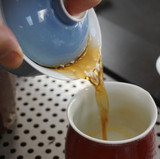The Many Lives of a Gaiwan Lid

If you’ve ever brewed tea with a gaiwan, you know it’s a simple piece of teaware: just a bowl, a saucer, and a lid. Simple, yes, but it does take some practice to master and here’s the secret — the lid is where the magic really happens.
Not only does it serve countless functions, but it also bears the heaviest burden of all: it’s the part that most often breaks. One of my tea teachers in Taiwan used to love giving mini lectures and demos about all the ways a gaiwan lid could be used. After years of brewing, spilling, and learning, I can confirm — that little porcelain disc is basically a multi-tool for tea survival.
1. The Obvious: Keeping the Heat In
First and foremost, the lid does what lids do — it keeps the heat inside. When you’re brewing tea, this helps maintain a higher temperature so the leaves can unfurl and release their full aroma and flavor.
2. The Strainer: A Perfect Pour
Here’s where things get interesting. With a slight tilt, the lid turns into a built-in strainer. By creating just the right gap between the lid and the bowl, you can pour out the tea liquor while holding the leaves back. This is particularly useful when we are going for multiple infusions.
Think of it like straining pasta with the pot lid — except in this case, you don’t end up with a sink full of spaghetti. The gaiwan lid was designed for this precise function.
3. The Aroma Evaluator
Once you’ve poured your tea, hold the lid to your nose. This moment — inhaling the rising fragrance from the lid — is one of the most intimate ways to connect with your tea. The leaf’s aroma and quality can be interpreted by the residual scent.
4. The Stirring Tool
Hold the lid perpendicular to the bowl and use it to gently agitate the leaves. This helps you check the progress of the brew — or simply interact with the tea in a tactile, meditative way. Sometimes you can tell a lot about how the tea is evolving just by watching how the leaves move.
5. The Silent Messenger
In traditional teahouses in parts of China, the position of your gaiwan lid could send a clear message to the attendant:
- Tilted to the side — “Please add hot water.”
- Upside down in the bowl — “I’m done.”
It was an unspoken communication system, efficient and elegant.
And there’s even a more obscure version: rotating the lid clockwise or counterclockwise a certain number of times was said to signal group affiliation — a kind of secret handshake or “tea gang sign” for the initiated.
6. The Cup in a Pinch
Lost your teacup? The lid’s shallow curve works surprisingly well as an emergency drinking vessel. It’s not the most refined method, but it gets the job done — especially when sharing tea outdoors or on the road.
The Lid That Does It All
From heat retention to straining, aroma evaluation, stirring, signaling, and even sipping — the gaiwan lid truly does it all.
It’s elegant, functional, and quietly indispensable. And yet, it’s also fragile — often the first part to break. Maybe that’s fitting. For something that carries so much purpose, it’s only natural that it also bears a little extra vulnerability.
So next time you lift that lid, remember: it’s not just a piece of porcelain. It’s a teacher, a tool, a communicator — and, in its own way, a survivor.
